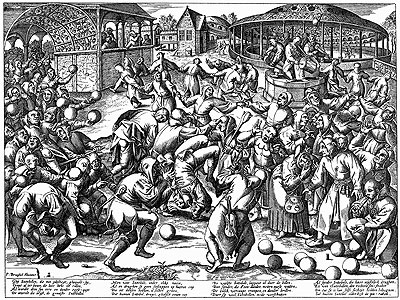It was the Church that first banned the theatre somewhere around 500 A.D. and then it was the same Church that reinstalled the official theatre about five or six hundred years later. Off course it has been theatre during those 500 – 600 years, but no official theatre. We are talking about jugglers, jesters, storytellers, small traveling companies of minstrels and other forms of Vulgar Comedy. Therefore it is also difficult to find anything written about it.
Maybe the fact that there was no official theatre actually helped Commedia dell’Arte, with its unofficial character, to develop. The influence from a theatre that developed far away from the institutions and rulers might very well have been a very one of the strong foundations that Commedia dell’Arte it built upon.
When the Church later reestablished the theatre it was first of all to make itself understood. The early Christianity was developed in Rome where people spoke Latin. Later in the middle ages national or regional languages had developed I most of Europe. The Roman Catholic Church did not stop preaching in Latin until 1963. So when people didn’t understand the ceremony it was convenient to use theatre to show episodes in the Bible.
This grew from dramatized episodes to actual plays, like morality plays and passion or miracle plays. The performances could take up to a week to perform and use most the citizens of a town, like in Chester where it took three days, in York it was only for one day buy it lasted from 4.30 am to 10 pm.
Everyone understands that during this long the audience also needs to be entertained, not just educated.
Now Jesus is a good guy in many ways, but he is not funny. If comedy is defined as the struggle back to balance from slipping on a banana peel, metaphorically speaking, then Jesus has no place there, since he never loses his balance. In this respect comedy is the opposite of harmony.
So what to do? Bring in the devils! That was what happened. The devils became the clown of the miracle plays. They even got their own section: the Diavolos. The Diavolos became very popular since they were funny and people could identify with the devils. The other characters were all serious representatives of the official world (see THE MARKET).
Very soon the Carnival started to use the masks of the devils, as we have seen in THE CARNIVAL. Remember the myth of Arlecchino’s wart on his forehead being the remnant of his devil horn or how egg sellers at the carnival dressed up as devils.
One thing more, when we talk about the Church and Commedia dell’Arte, is the decay of the church’s power in society. The secular rulers gained power and wanted to show it off. One way was to hire the minstrels and travelling companies that had been around in Europe into their courts. There they became jesters and entertainers for the court and they influenced the COMMEDIA ERUDITA, which we will talk about on the next page.
Back to THE ROOTS


Pingback: Commedia dell’Arte abroad - Commedia dell'Arte & Vulgar ComedyCommedia dell'Arte & Vulgar Comedy
Pingback: Charlatano and the square in Commedia dell’Arte (Part 1) |
Pingback: Vulgar Comedy and the Church (Part 1) |
Pingback: Carnival and the popular feast (Part 3 – The structure of the celebration) |
Pingback: Stupidity, animal behavior or/and amorality in Commedia dell’Arte |
Pingback: Transformations in Commedia dell’Arte |